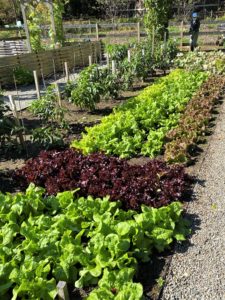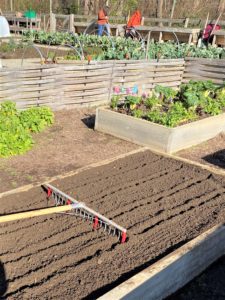Last month, we focused on how to decide what to grow in your vegetable garden, what vegetables should be started indoors and transplanted into the garden, and what vegetables can be direct seeded into the garden once the dangers of frost have passed.
This month, we take the next steps in developing a successful vegetable garden by determining the best place to put our vegetables, how to assess and amend the soil, and prepare the bed for seeds and seedlings.
When it comes to deciding where you put your vegetable garden, there are several things that need to be considered:

Sunlight – As a basic rule of thumb, vegetables grown for their fruit or roots (such as tomatoes, pepper, carrot and potatoes) require full sun (six+ hours of sunlight per day). Vegetables grown for their leaves, stems or buds often do quite well in part shade, so no need to despair if your garden is shaded part of the day. A good number of vegetables produce nicely with three to six hours of sunlight (such as beans, broccoli, cauliflower, collard greens and kale) or with constant dappled sunlight. Keep in mind that none of our ‘classic’ vegetables can thrive in deep, dense shade, so if your yard feels more like a woodland you might want to look into native edible woodland plants, like paw-paw or ostrich fern to fill your food growing needs.
Once you’ve got your spot picked out, orient your garden from north to south, if possible, to get maximum sun exposure. When plants are positioned from east to west, they can shade each other out, especially if they are already competing for limited solar resources. If your yard is soaking up the sun all day long you don’t have to worry about this quite as much!
 Water – Be sure to locate your garden in a place where there is well drained soil. Healthy soil should be able to retain about 25% of its volume in water – much more and your plants will get water logged; much less and they risk drying out. The good news is typical garden soil in our area generally meets that requirement (though it’s always a good idea to do a soil test to confirm!). If you have a healthy lawn, chances are you can have a healthy veggie garden too. But don’t give up if your soil is too wet or too dry! You can always amend your soil to get the conditions right. Organic matter (decaying plant or animal material, otherwise known as compost) put into the soil, will hold water so that plants can use it when they need it. Alternatively, if your soil is too moist, you can either choose a higher spot in your yard or build a raised bed box, which you can fill with blended topsoil and compost to give the plants the drainage they need.
Water – Be sure to locate your garden in a place where there is well drained soil. Healthy soil should be able to retain about 25% of its volume in water – much more and your plants will get water logged; much less and they risk drying out. The good news is typical garden soil in our area generally meets that requirement (though it’s always a good idea to do a soil test to confirm!). If you have a healthy lawn, chances are you can have a healthy veggie garden too. But don’t give up if your soil is too wet or too dry! You can always amend your soil to get the conditions right. Organic matter (decaying plant or animal material, otherwise known as compost) put into the soil, will hold water so that plants can use it when they need it. Alternatively, if your soil is too moist, you can either choose a higher spot in your yard or build a raised bed box, which you can fill with blended topsoil and compost to give the plants the drainage they need.
Soil – In the preparation of an organic garden, it is important to add in compost and certified organic fertilizer. To make the best use of the soil for your garden, you should test your soil every three to five years. Penn State’s Agricultural Analytical Service Lab (agsci.psu.edu) provides tests at the cost of $9.00 with results coming in about 10 days, or purchase tests at your local garden center. The best time to get a sampling is in the early spring or late fall. This assures that you will have the soil test results and recommendations, so you’ll know what to add to have a successful vegetable garden. One to two inches of compost should be added every year to established gardens, and four to eight inches of compost should be added for the first year or two of a new garden spot. Yearly adding of compost may eliminate the need for the addition of fertilizer. Do not over fertilize. Our temptation when we garden is to want to give our little plants the best of everything. More plant food must be better, right? Not necessarily! Plants need the right balance of conditions. Too much fertilizer can burn plants or overstimulate leaf growth at the expense of fruit production.
 Now you are ready to do soil preparation by loosening 18” of the soil for aeration. This will allow the roots of the plants to travel freely through the soil to find the nutrients they need. Tools needed are no more than a round nosed shovel and a hard rake. If you’re adding compost and a good organic (also called natural) all-purpose vegetable fertilizer (which include dried manures, bone and blood meal, and cottonseed and soybean meals), make sure it is labeled 5-10-5 or 5-10-10 (percentage of nitrogen, phosphorus, and potassium). Read the back of the package to know how much to apply. Mix your compost and fertilizer into your soil. The final step is to rake your soil smooth for planting.
Now you are ready to do soil preparation by loosening 18” of the soil for aeration. This will allow the roots of the plants to travel freely through the soil to find the nutrients they need. Tools needed are no more than a round nosed shovel and a hard rake. If you’re adding compost and a good organic (also called natural) all-purpose vegetable fertilizer (which include dried manures, bone and blood meal, and cottonseed and soybean meals), make sure it is labeled 5-10-5 or 5-10-10 (percentage of nitrogen, phosphorus, and potassium). Read the back of the package to know how much to apply. Mix your compost and fertilizer into your soil. The final step is to rake your soil smooth for planting.
What if your yard isn’t set up for a traditional in ground vegetable garden? What if you have a very small space to work with, or even just a patio? There are still ways to get in on the veggie garden game! Employing things like raised beds, vertical gardening or container planting can help you grow your own food, no matter how much space you have. For more information on these types of gardens check out this free webinar series. You might be surprised what your patio or windowsill can grow! You can also read more on the Tyler Blog about making the most efficient use of the space you have with succession planting.
There are few things more satisfying than growing your own food. With a little work, you could be reaping the benefits of your home garden for months to come!






